Budgeting can be an excellent way to take back control of your money. When you spend without a plan, this is an easy way to blow through your income as you try to stretch those dollars until the next payday.
That’s where the 70-20-10 can help you break the cycle of living paycheck to paycheck.
It’s a simple percentage-based way to manage your monthly income that makes room for living essentials, saving, paying down debt, and investing.
Related Posts:
- How to budget when you get paid biweekly
- What is the 50-30-20 budget rule?
- How to create a budget with irregular income

Table of Contents
What is the 70/20/10 budget rule?
The 70-20-10 rule can be a great way for beginners to budget and manage their money.
Like other budgeting methods such as the 50-30-20 rule, this guideline divides your post-tax income into three categories:
- 70% of your income towards your monthly spending
- 20% of your income towards your savings
- 10% of your income towards giving, investments, and additional debt payments
First, the 70% should go towards anything you spend money on, such as your fixed and variable expenses, but what you do with the remaining 30% of your income is up to you.
When it comes to the 20% for savings and 10% for giving and investments, I have seen many people suggesting different ways you can allocate your money to these two categories.
Below are a few examples to get you thinking:
- 20% for savings and 10% for paying off debt.
- 20% for savings and 10% for investments OR donating (if you don’t have any debt).
- 20% for savings and debt repayments and 10% for investments OR donating.
- 20% for paying down debt (if you have a lot of high-interest debt) and 10% for savings.
- 20% for savings and debt repayments and 10% for something fun.
I personally believe the best option is to allocate 20% for savings and debts and 10% for investments.
70% of your income is for monthly spending
With the 70-20-10 budget rule, 70% of your after-tax income will go to living expenses, including your needs, wants, and anything else you spend money on. Below is a list of the most common expenses to include:
- Mortgage or rent
- Utilities (electricity, water, garbage removal)
- Insurance (car, homeowners, life)
- Car payment
- Transportation and gas
- Phone and internet
- Groceries
- Restaurants and dining out
- Entertainment
- Subscriptions and memberships
- Clothing
- Personal care items
- Child care
- Travel costs
- Medical costs
- Gifts (unless you prefer to keep this under the 10% giving category)
- Minimum payments on debts (credit cards, student loans)
Unlike other budgeting methods, such as the 50-30-20 rule, you don’t have to breakdown your expenses by necessities and discretionary spending. But you may find it helpful to split your expenses into fixed and variable costs.
Fixed vs. variable expenses
Your fixed expenses don’t change from month to month or period to period.
And they usually take up the largest percentage of your budget because they include things like housing, utilities, insurance, car payments, and transportation.
Some of your fixed expenses may be discretionary, such as streaming services like Netflix or a gym membership.
Even though they aren’t considered essential living costs (meaning you could probably survive without having these things), these bills are consistent each month and paid on a regular basis.
Examples of common fixed expenses:
- Rent or mortgage payment
- Utilities (water, electricity, gas) – Sometimes these are variable depending on the time of year
- Car payments
- Insurance
- Subscriptions and memberships
- Child care
- Medications
Your variable expenses are your daily living expenses, such as buying groceries, eating at restaurants, drinking Starbucks, buying clothes, traveling, or going to a concert with friends.
They are considered variable because the amount you spend can change from month-to-month.
Most of your variable expenses are discretionary, which means they are not essential living costs. They are the things that you want and are nice to have but are not necessary.
However, some variable expenses are necessities, such as groceries or buying gas for your car to get to work.
The key here is to make sure that you’re spending less than the income you bring in each month.
Examples of common variable expenses:
- Groceries
- Gas and transportation
- Restaurants and dining out
- Entertainment and hobbies
- Clothing
- Travel
- Household products
- Personal care products
20% of your income is set aside for savings and debts
20% of your after-tax income will go towards your savings category. This can help set your future self for success.
One of the major roadblocks many people face in saving money is that they simply don’t have any money left over to save after paying their living costs.
Living paycheck to paycheck can make it challenging for anyone to save money. If you can relate, then you’re in good company.
According to a recent survey from Bankrate, 56% of Americans said they are unable to cover an unexpected $1,000 bill with their savings.
Instead of using their savings, many Americans would need to go into debt to pay for an unexpected bill.
The 70-20-10 budget rule will help you prioritize your savings so you can build an emergency fund quickly and work towards your larger savings goals.
However, no matter your situation, everyone should make it a goal to save a decent portion of their income.
Examples of what you can include in your savings category:
- Emergency fund
- Sinking funds for future expenses
- Money to start a business
- Money to buy a house
- Retirement contributions – 401(k), IRA, Roth IRA
- College savings plan for your kids – Custodial accounts and 529 plans
Include an emergency fund in your 70-20-10 budget
If you’re just starting your financial journey, I recommend building a $1,000 emergency fund. This is money that you’ve set aside to cover unexpected expenses.
After you’ve saved up your starter emergency fund, most financial experts recommend growing your emergency fund so you can cover between three and six months of expenses.
However, if you don’t have a steady paycheck or you work in an industry that isn’t secure, then you may want to build a bigger emergency fund.
Also, you’ll want to put your emergency fund into an account that makes it easy to access the money when you need it. I recommend using a high-yield savings account.
Sinking funds for future expenses
These are things that you have an annual payment on, such as insurance, Amazon prime, Christmas, clothing, medical, and so on.
It’s something you’re continuously saving up for, knowing that it will eventually come. And when it does come, you will have your payment ready. Such as a buying new car, going to a wedding, or taking a vacation.
You won’t feel guilty about spending that money because that’s what it was there for the entire time. You can list them in alphabetical order (or however you wish).
Examples of common sinking funds:
- Christmas
- Vacation
- Wedding
- Medical expenses
- Property taxes
- Self-employment tax
- Birthdays and gifts
- Kids activities (summer camps, club fees, back-to-school supplies)
- Special occasions (date nights, anniversaries, parties, holidays)
- Annual renewal expenses
- Clothing
- Home maintenance
- Pet care
Debt repayments
If you’re trying to pay down debt, you’ll want to use this 20% category to put money towards your high-interest debt, such as credit card debt and loans.
This doesn’t mean that you can only spend less than 20% of your income on debt repayments. Remember that the minimum payments on debts were included in the 70% living expenses category.
But if you’re carrying a lot of urgent debt, which is expensive debt that is negatively impacting your credit and costing you a ton of money in interest each month, then you should make paying this off your first priority.
Of course, you’ll want to use your own judgement and decide which debt is most urgent for you to tackle. Finding the right debt repayment method can help you get on the path to debt freedom quickly.
Debt snowball method
The debt snowball method targets debts with the smallest balance first.
This means you’ll pay the minimum monthly payments on all your debts, then funnel any extra money each month to the smallest balance first.
You’ll pay off your debts in order from smallest to largest, regardless of interest rate.
When the smallest debt has been paid off in full, then you’ll put any extra money towards paying off the next smallest balance.
What makes the snowball method appealing, is that it can help you stay motivated by focusing on quick wins.
Personal finance is all about mindset, and when you see your progress faster, you’re more likely to stick to your game plan in the long-term.
Read Next: Debt snowball vs. Debt avalanche method – What is the best way to pay off debt?
Debt avalanche method
The debt avalanche method attacks debts with the highest interest first.
This means you’ll pay the minimum monthly payments on all your debts, then funnel any extra money each month to the highest interest rate debt first.
You’ll pay off your debts in order from highest interest rate to the lowest, regardless of balance.
This method could save you the most money in interest fees and has the potential to get you out of debt faster.
If you want to save the most money, then follow the debt avalanche method. Since you’re focusing on paying off debt with the highest interest rate (most expensive one) first, this means you’ll pay less overall.
10% of your income goes towards giving and investments
10% of your take-home income will go towards your investment category.
Choosing the right investments can help you build wealth and reach your big financial goals. Thanks to the power of compound interest, this can make your money work for you.
Examples of ways you can invest your money:
- Investing in stocks and bonds
- Real estate investments
- ETFs or mutual funds
- Cryptocurrency
You can also choose to donate 10% of your income to a charity or organization that you feel really passionate about. This can be regular donations that you make each month to the same cause, or you can vary your giving from month to month.
Some people give 10% of their income to church or their place of worship, known was a “tithe”. Other options include donating to a charity or non-profit organization.
What you choose to do with this 10% category is up to you.
How to follow the 70-20-10 budget rule
You can create a personal budget following the 70-20-10 rule in just 5 simple steps.
Step 1 – Calculate your after-tax income
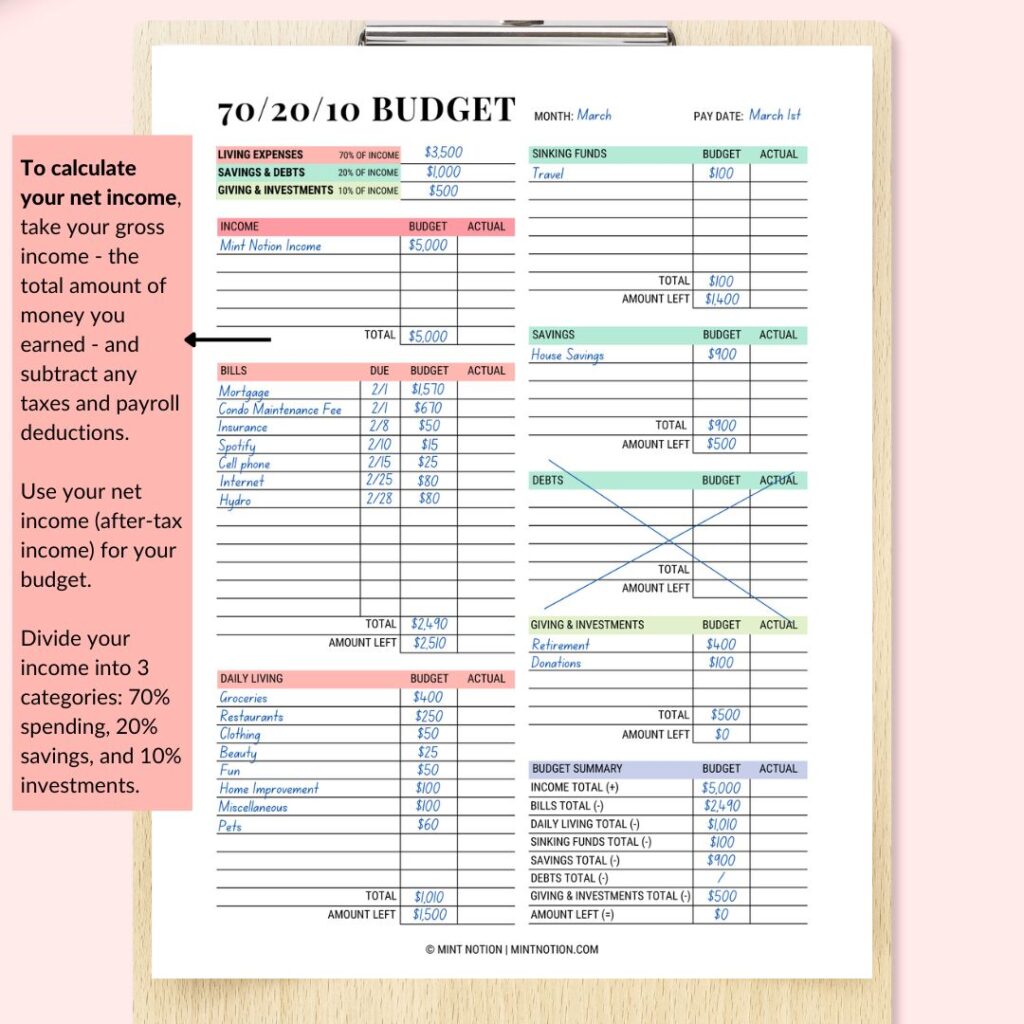
The first step is to calculate your monthly take-home pay. This is your after-tax income, also known as your net-income, rather than your gross income.
To calculate your take-home income, subtract any taxes and pretax payroll deductions from your gross income.
If you’re using my 70-20-10 budget template, you’ll write down your income under the “Income” section.
If you’re an employee with a steady paycheck, this amount will appear on your paystubs. If your employer deducts retirement contributions, health insurance fees, or automatic savings, add those back in.
If you’re self-employed, this is your gross income minus your business expenses and the amount you set aside for taxes.
If you’re budgeting together with a partner, you can add your after-tax income together to make a budget for your household.
Once you’ve calculated your monthly take-home pay, you can divide your income between three spending categories: Living expenses (70%), Savings (20%), and Investments (10%).
NOTE: When planning your budget, write everything under the “Budget” column. Then at the end of the month, write down what you actually spent in the “Actual” column.
2 – Write down your living expenses
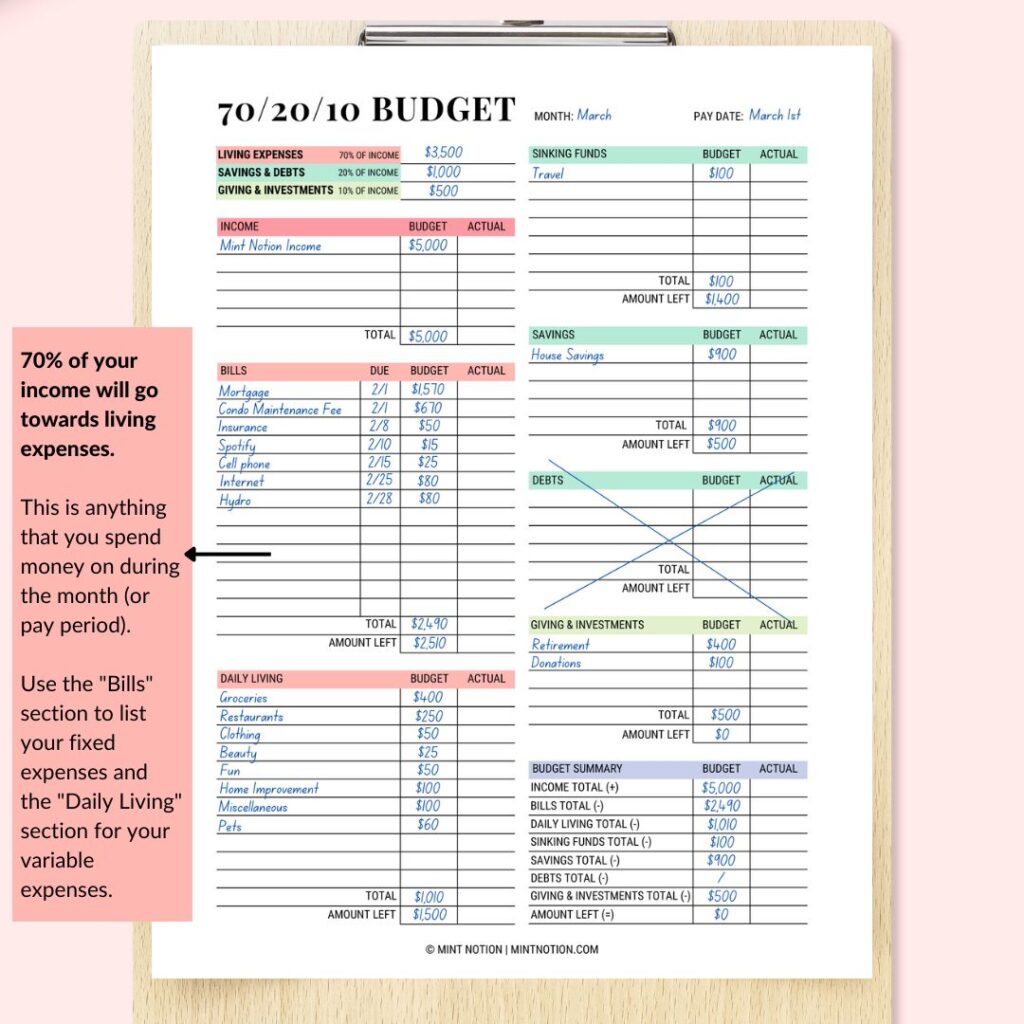
The next step is to figure out how much money you currently spend on your fixed and variable expenses.
If you’re using my 70-20-10 budget template, start off by writing down your bills and fixed expenses under the “Bills” section. Then write down your other living costs and variable expenses under the “Daily Living” section.
You want to aim to spend 70% of your monthly after-tax income on your living expenses. This includes anything that you spend money on during the month, including the minimum payments on debts.
If you don’t know how much you spend on these items, you can check your bank and credit card statements for the past 3 months, and take an average, to help you determine how much you’re going to spend.
This will look different for each person, depending on your lifestyle and what you’re willing to sacrifice.
For example, one month may involve higher spending on gifts and another month higher for entertainment.
3 – Set aside money for your savings and future expenses
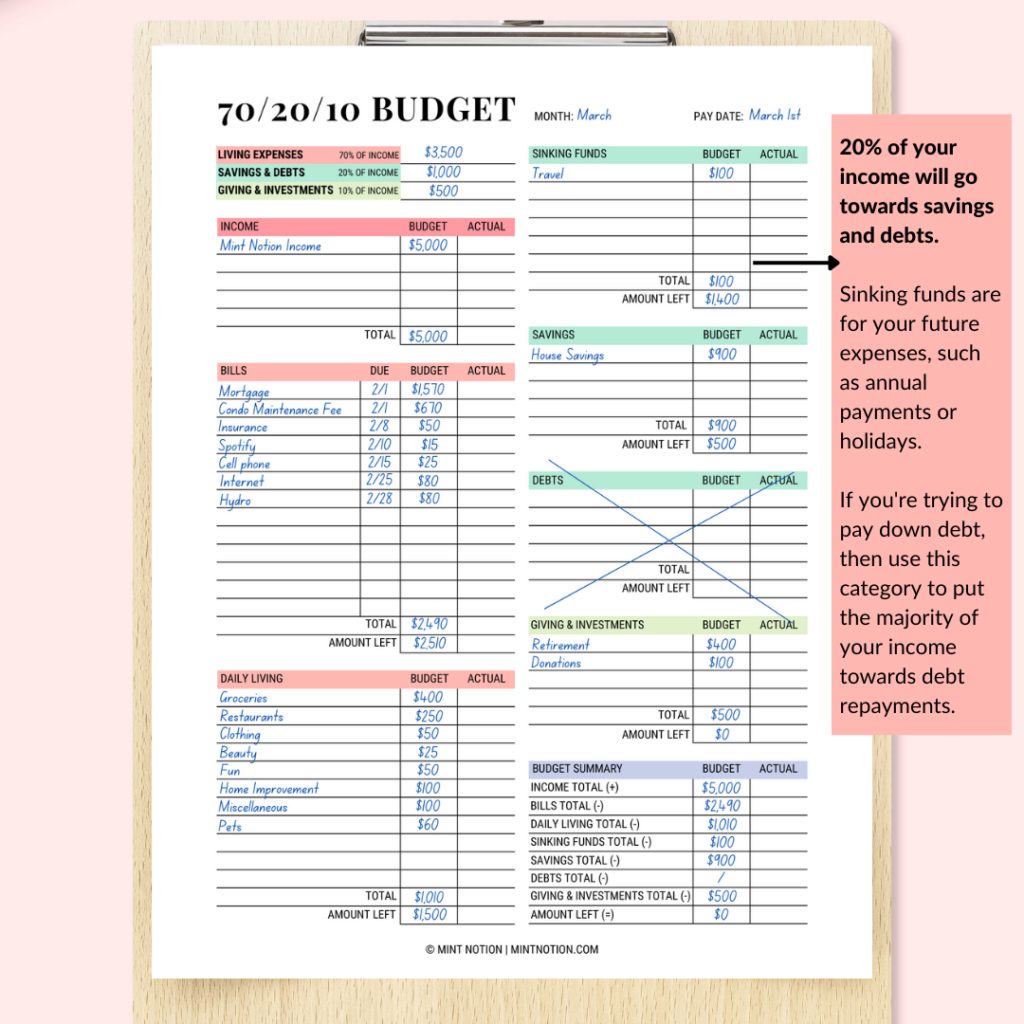
The next step is to allocate at least 20% of your income to savings and debt payments.
If you’re using my 70-20-10 budget template, start by writing down the sinking funds you’d like to save for under the “Sinking Funds” section.
Then write down your savings under the “Savings” section, and debts under the “Debts” section.
Minimum payments on your debts are considered part of the 70% section for living expenses.
Any extra payments to reduce your debts will be classified as “savings” and goes under the 20% section.
The key to being successful with your budget is to get clear on your WHY and set meaningful financial goals. This can help you stay motivated to keep yourself going each month and stick to your budget.
Some popular financial goals include starting an emergency fund, paying off debt, savings for retirement, saving for a down payment on a house, paying off your car, investing in college education, saving for a dream vacation, a wedding, or something fun.
Having a good understanding of your income and expenses can help you set realistic financial goals. This is because you’ll know how much money you can put towards them or find ways to reduce your expenses so you can reach your goals faster.
NOTE: If you’re living paycheck to paycheck, then you may find that saving 20% or investing 10% of your income seems impossible right now. Don’t worry.
Take a moment to breathe and remind yourself that you’re doing the best you can right now.
This 70-20-10 rule is just a guideline and if you’re spending money than 70% of your income on living expenses, that’s okay.
When I first started my personal finance journey, that majority of my paycheck was going towards my living expenses, which left me with very little money to put towards my savings.
It’s not easy, but I tried to make it a habit to set aside whatever I could afford to deposit in my savings account.
I also made a lot of sacrifices and reduced my variable expenses to make it possible. Eventually my income grew and so did my savings.
4 – Invest or donate 10% of your income
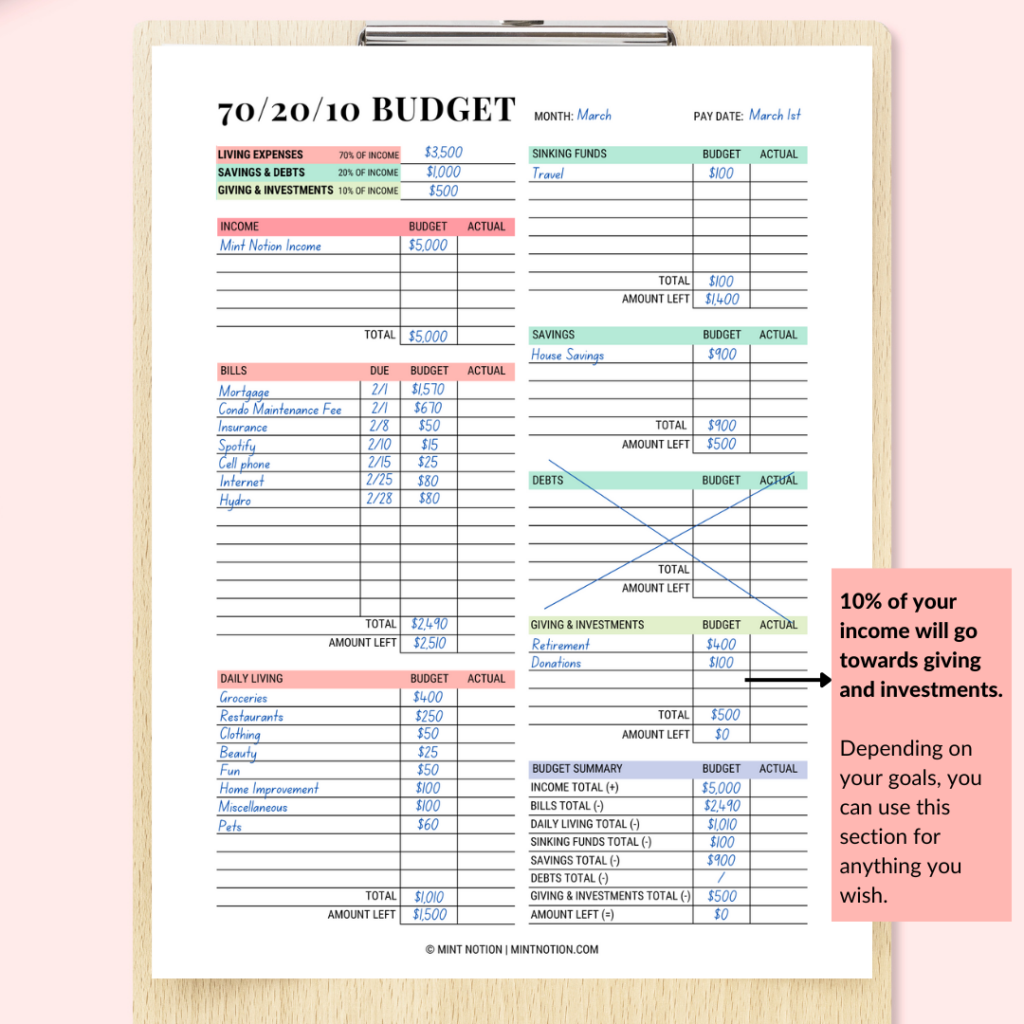
The remaining 10% of your income will go towards investments or giving. You get to decide how you want to spend your money.
Many budgeting plans don’t factor in investing or donating, which makes the 70-20-10 rule unique. This allows you to prioritize your savings, debt payments, and investments depending on your goals.
For example, if you don’t have debt, then you can allocate the full 20% section to your savings and 10% to investing.
If you have more wiggle room in your budget, you can even include giving under the 70% section and invest 10% of your income.
5 – Track your spending and make adjustments as necessary
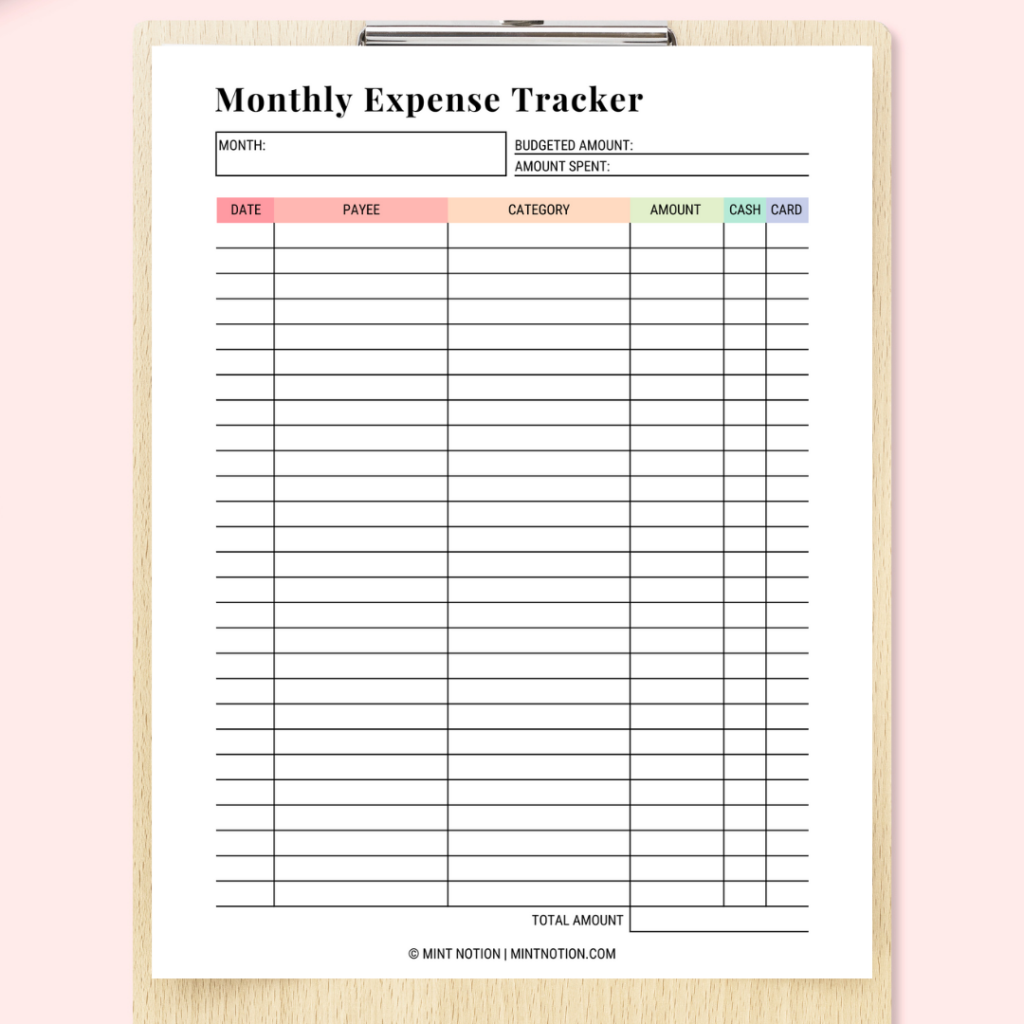
YAY! You’re already on your way to taking control of your money and doing amazing things! I am so proud of you!
To make sure that your budget is working for you, the next step is to track your spending once the month begins.
This will help you see if you’re staying on budget, and it will let you know how much money you have left to spend in each budget category.
When you track your spending, this gives you a huge sense of control over your money. You don’t have to worry if you have enough to get groceries because you’ve already made a plan beforehand and stuck to it.
The best to track your spending way is to find an easy method that works for you. For example, you can use an app for your phone or tablet, a spreadsheet, or keep it simple by using a pen and paper.
I personally like to use this worksheet to track and manage my monthly spending. Every time I spend money, I record the transaction on this worksheet.
This can include both your fixed and variable expenses, as well as your debt payments.
Then at the end of the month, I like to use a highlighter to highlight each spending category with a different color.
This helps me to keep everything organized and see exactly how much money I spent for the month on bills, groceries, clothing, restaurants, and so on.
Read Next: 4 ways to track your monthly expenses
Tracking your spending can also reveal any spending issues you might have and help you stick to your budget.
For example, when I first started budgeting, I didn’t realize just how much money I was spending on clothing and restaurants.
Don’t get discouraged if you’re having trouble sticking to the 70-20-10 percentages. Nobody gets it perfect on the first attempt.
It can take a few months before you start to get the hang of it and begin to feel more confident about your budget.
How to know if the 70-20-10 budget is right for you
Similar to the 50-30-20 rule, the 70-20-10 budgeting method can be an excellent option for people who are new to budgeting.
I personally think that it’s easier to follow than the 50-30-20 rule because you don’t have to separate your “needs” and “wants”. Instead, you’ll put all your expenses into the 70% section.
If you have a lot of expenses, you don’t have to worry about allocating them to certain percentages. Instead, you only need to worry about separating your take-home income into 3 categories: 70% living expenses, 20% savings, and 10% investments.
If you’re socially conscious, you may find the 70-20-10 appealing because it includes a category for donating. But before giving to others, it’s important to be financially stable.
Once you feel that you’re in a comfortable financial position, then you can decide if it’s the right time to give back to others.
The 70-20-10 budget rule can be great for those who:
- Never budgeted before
- Want to prioritize savings or paying down debt
- Want a simple budget method
- Have a lot of individual expenses
- Want to give back and donate to something their passionate about
Advantages of the 70-20-10 budget
One of the main advantages of the 70-20-10 budget is that it’s a simple way to manage your money.
Once you’ve separated your take-home income into the three categories – spend, save, and share – you’re free to spend it anyway you wish.
If you stick to the 70-20-10 rule, you won’t have to worry about overspending or sabotaging your savings goals or debt payoff plan.
This budgeting method is less restrictive than other budgets because it gives you a general guideline on how to organize your money.
When it comes to spending 70% of your income on living expenses, you can divide up the spending categories any way you want.
Pros of the 70-20-10 budget rule:
- It’s simple to use
- It’s less restrictive than other budgets
- It can help prioritize your savings, debt payoff plan, and investments
Disadvantages of the 70-20-10 budget
Personal finance IS personal and the 70-20-10 budget rule will not work for everyone. While this can be an excellent choice for new budgeters, you must remember to try and make this work for you.
This 70-20-10 rule is just a general guideline and it’s important to consider your own lifestyle and goals.
For example, if you’re living paycheck to paycheck, then you may find it difficult to save 20% of your take-home income or even 10% for giving and investments.
This budgeting method is ideal for those who can afford to set aside 30% of their income for something beyond living expenses.
On the other hand, if you can comfortably spend less than 70% of your income on essential living expenses, then you may want to consider setting aside a larger portion of your income to pay off debt, save, or invest.
And while many people may love the simplicity of the 70-20-10 rule, others may thrive better with a more detailed budgeting method.
The goal of your budget should help you get closer to the person you want to be, rather than try to fit yourself into a framework that isn’t right for you.
Another drawback of the 70-20-10 budget is that it doesn’t separate your “needs” and “wants”.
Being able to see what percentage of your income goes towards essentials vs. non-essential costs can help you identify areas to improve in your budget.
For example, you might notice that you’re spending a large portion of your income on dining out which is making it difficult to set aside money for savings of debt repayments.
Or on the other hand, you may notice that you’re working really hard and can afford to spend a little extra on luxuries.
Cons of the 70-20-10 budget rule:
- Saving 30% of your take-home income can be challenging for some households
- It doesn’t separate your “needs” and “wants”
- Some prefer a more detailed budget
70-20-10 budget example
Let’s say you make the average salary of someone living in Toronto, which is $62,050. After taxes, your monthly net income is $3,950 per month.
Below is an example of a single person who rents in Toronto, has no kids, and works primarily from home. When following the 70-20-10 rule, they would allocate their income as such:
- 70% living expenses – $2,765
- 20% savings – $790
- 10% investments – $395
Income
- $3,950 per month
Fixed expenses
- Rent $1,600
- Utilities $150
- Transportation $50
- Subscriptions $35
- Cell phone $60
Variable expenses
- Groceries $400
- Entertainment $150
- Clothing $40
- Restaurants $200
- Household $80
Savings
- Emergency fund $100
- Savings Account $50
- Debt repayments $640
Investing
- Donations $95
- Stock investments $300
All of the money in this example is allocated based on the 70-20-10 percentages. You can combine all of your living expenses together or divide them based on fixed and variable expenses as I did in the example.
To keep things simple, I used basic spending categories in this budget example, but you can be as specific as you would like.
Instead of simply writing “Utilities”, you can specify water or electricity. The more details you provide, the easier it will be to understand where your money is going.
70-20-10 budget template
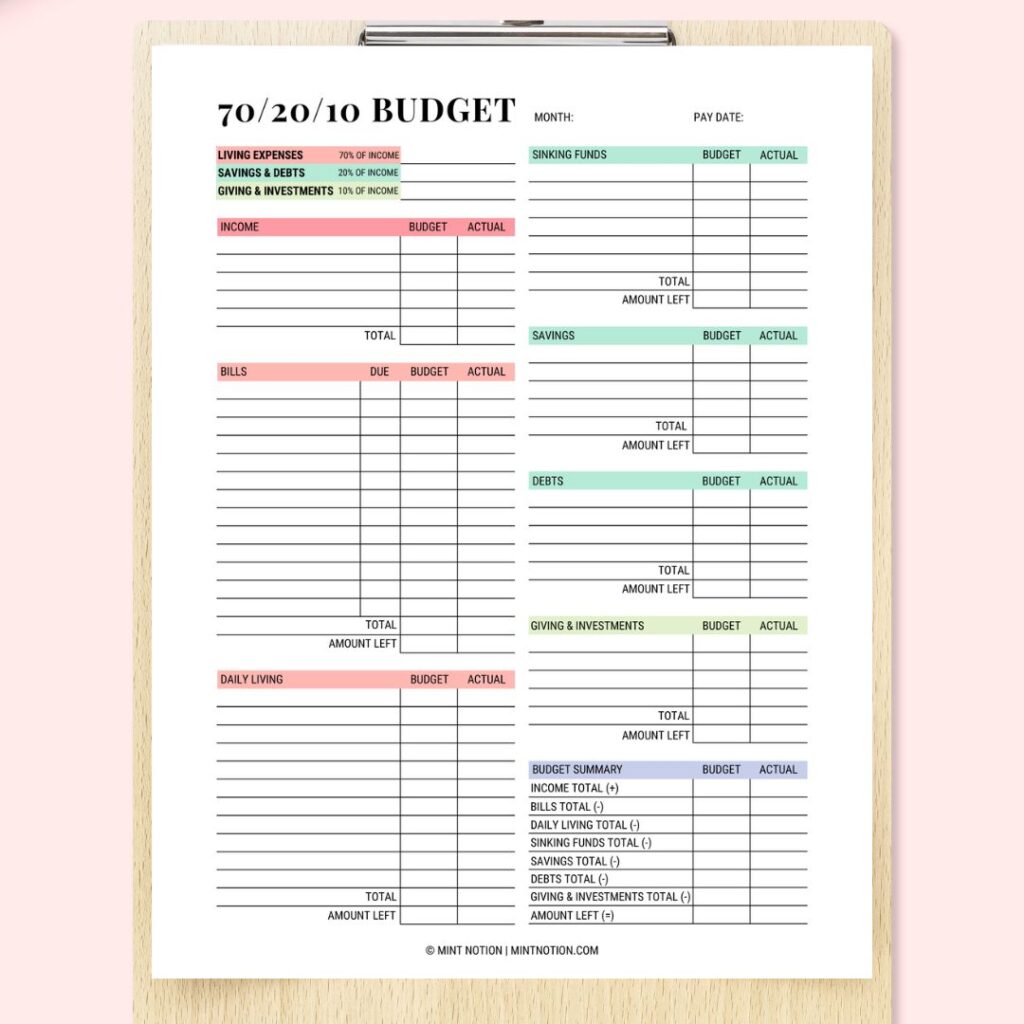
After reading this post, you probably have a good idea if the 70-20-10 budget rule is right for you.
It doesn’t hurt to try a new budgeting method, especially if you’re looking to reduce your living expenses and prioritizing paying off debt.
I’ve created a printable Budget Planner that includes a 70-20-10 budget worksheet. This can help you start taking back control of your finances and achieve your goals.
With some careful planning, you can create a budget that makes it easy to manage your money, payoff debt, and still having room for the fun stuff.
